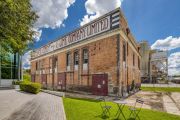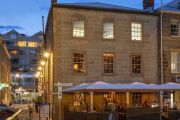
Pentridge Prison's old D Division building turns over a new leaf as luxury wine storage centre
It was once home to some of Australia’s most notorious criminals, such as Mark ‘Chopper’ Read, murderous gangster Squizzy Taylor, massacre-fantasist Garry David and bushranger Ned Kelly.
But now the D Division of Melbourne’s infamous Pentridge Prison is to house a completely different kind of prisoner locked in its cells – thousands upon thousands of bottles of fine wine.
The historic bluestone building is being converted into individual wine cellars in each of its old 200-odd cells, with capacity to hold between 1000 and 2000 bottles, depending on the configuration.
“There’s certainly going to be no problem with security!” said Paul Tardivel who, together with business partner Michael Woodworth, has bought the building for its newest incarnation. “And the walls are bluestone half-a-metre thick so it’s perfect for storing wine at cool temperatures.
“It can be a very eerie place to be in on your own late at night, but I do tell people I’ve met all the ghosts, and they all seem to be OK!”
Each of the cells have been individually strata-ed and 20 are now being put up for sale in the first tranche, each fully-fitted out with climate-control units and a choice of racking. Prices start at $115,000 each, with strata levies of $400, and council rates of $300, a year.
The new Pentridge Cellars facility will be open 24 hours a day, with access via swipe cards. There’s also a communal area for events, wine-tastings or owners to showcase their own collections.
The impressive three-storey, heritage-listed building was sold to the entrepreneurs on condition they also build an interpretative museum at the site about the ‘Bluestone College’, as the prison in Coburg was known, charting its colourful history.
The Heritage Council of Victoria currently has 17,000 artefacts from the 146 years Pentridge functioned as a prison, from its build in 1851 to its closure in 1997.
The 12-hectare precinct is currently undergoing a massive redevelopment with apartments, retail and restaurants, and the preservation and adaptation of any heritage-significant buildings.
“Melbourne is the heritage centre of the country and this building is probably one of the best-preserved historical icons we have,” said finance broker Mr Tardivel, 61.
“It’s ideal for wine storage as the walls mean the temperature doesn’t change much, and certainly not vastly or rapidly.
“We’ll be keeping a number of cells in their original condition for the museum. We’ve both got involved in the history of the building now – we’d been trying to acquire this building for two years – and we find it very exciting. It’s such a stunning building, steeped in history, and with so much atmosphere.”
D Division was built at first for female prisoners, and then converted for males, and finally transitioned to a remand wing. With Ned Kelly’s remains one of 44 bodies originally buried on-site, and as the location of the last hanging in Australia in 1967, of Ronald Ryan who shot dead a prison officer during an escape, it’s long been a focus of much curiosity.
Regular ghost tours visit D Division, and Mr Tardivel and banker and mortgage broker Mr Woodworth, 56, are being constantly approached by companies who want to hold events, and film and TV companies seeking permission to film.
The idea for the wine cellars on Wardens Walk came when Mr Tardivel was between homes and his collection of Penfolds Grange started to go off. So staying in temporary accommodation, he’d sit down in front of the TV with a pizza and drink Grange with it each night. He laughed about it to Mr Woodworth, who was already considering trying to buy D Division.
“So we thought that would be the perfect place to store wine,” Mr Tardivel said. “Many people now live in apartments and don’t have the room to store wine or champagne property, and keeping them in a garage isn’t such a great idea, while creating your own cellar in a house would cost the best part of $100,000 anyway.
“With all the new restaurants coming to the precinct too, it’s the perfect place to just pop in and pick up a bottle to go with dinner. And this kind of property is so unique, it will always increase in value. It can’t possibly be replicated.”














